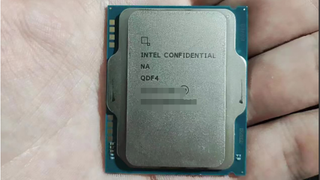Respected hardware leaker @wxnod has published a picture of what seems to be an Intel processor in LGA1851 packaging. The new chip could be Intel's Meteor Lake-S or Arrow Lake-S and its main difference with the current Raptor Lake-S is a slightly altered integrated heat spreader (IHS). Given that the image is published without any explanations, this could be a prototype of an Alder Lake processor that never hit the market.
Intel's sockets formally called LGA1700 and LGA1851 are essentially the same socket with 0.8 mm pitch, but the latter has more active pins. This allows makers of motherboards and cooling systems to maintain their designs. Meanwhile, LGA1851 will increase the height of IHS from 6.73-7.4 mm to 6.83-7.49 mm, according to earlier reports. To prevent installation of LGA1851 processors into 1700-pin sockets, the upcoming CPUs will have a different cutout configuration.
Perhaps the most interesting part about the processor marked as 'Intel Confidential NA QDF4' is their slightly larger heatspreader. It is unclear whether the taller heatspreader was made slightly larger to prevent bending that Intel's LGA1700 processors are known for, but this is certainly a possibility.
If the CPU is Intel's Meteor Lake-S, then it will never reach the market as the platform has been cancelled. Meanwhile, the processor still gives an idea how Intel's LGA1851 CPUs will look like when they come to market in 2024 in the form of Intel's Arrow Lake products.


